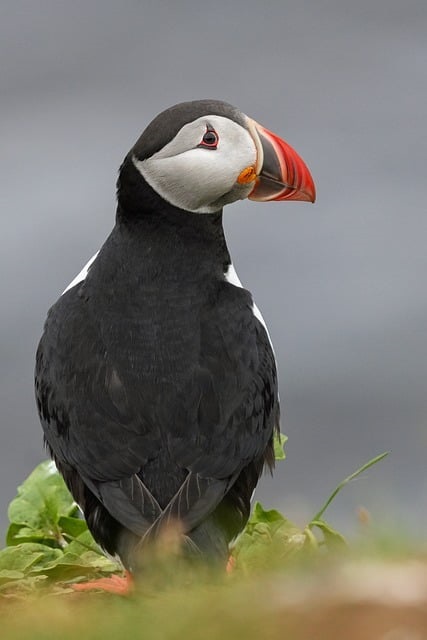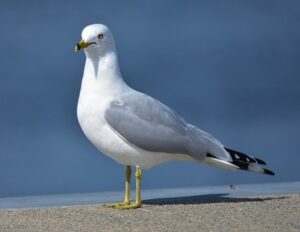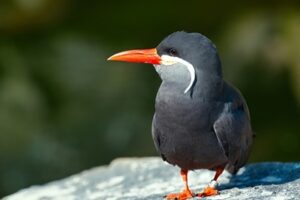Seabirds are among the most remarkable creatures on our planet, embodying the spirit of the ocean with their grace and resilience. They are not just birds that live by the sea; they are extraordinary avian species that have adapted uniquely to life in one of the Earth’s most challenging environments. Their presence is a testament to the interconnectedness of our ecosystems and the delicate balance that sustains life in the marine world.

Diversity Of Seabirds
Seabirds encompass a wide variety of species, each with unique adaptations and behaviors suited to their particular ecological niches. Among the most notable are the albatrosses, puffins, gulls, petrels, and terns.
Albatrosses: Albatrosses, with their impressive wingspans that can exceed 3.5 meters(12 feet), are known for their ability to glide over the ocean for hours without flapping their wings. They have mastered the art of dynamic soaring, using wind currents to travel great distances with minimal energy expenditure. These birds are not only skilled fliers but also have a remarkable sense of navigation, often returning to the same breeding grounds after journeys that can span thousands of miles.
Puffins: Puffins on the other hand, are small, colorful seabirds that are often referred to as “sea parrots” due to their distinctive beaks. They are excellent divers, capable of plunging underwater to catch fish, and are known for their endearing behavior during the breeding season when they return to their burrows to raise their young. Puffins are particularly charming and have become symbols of the rugged coastal environments they inhabit.

Gulls and Terns: Gulls and terns are perhaps the most familiar seabirds, found on coastlines and near inland waters around the world. Their adaptability allows them to thrive in a variety of environments, from urban areas to remote islands. Gulls are opportunistic feeders, often scavenging for food, which has led to their success in human-dominated landscapes. Terns, with their slender bodies and sharp beaks, are agile hunters, diving into the water to catch fish mid-flight. Each of these seabird species contributes to the rich tapestry of life in marine ecosystems.
Petrels: Petrels are also integral to seabird communities. Petrels are known for their graceful flight and are often seen skimming the ocean’s surface in search of food.
Ecological Importance Of Seabirds
Seabirds play a vital role in maintaining the health of marine ecosystems. As predators, they are essential components of the food web, influencing the populations of fish and other marine organisms. Their foraging behaviors help regulate fish stocks, and their presence can indicate the overall health of marine environments. For example, a decline in seabird populations often signals changes in fish availability or the impacts of pollution and habitat degradation.
Furthermore, seabirds contribute to nutrient cycling in marine ecosystems. When seabirds regurgitate undigested food and defecate, this can provide essential nutrients to the coastal and marine environments. This process helps fertilize the ocean and supports the growth of phytoplankton, the foundation of the marine food web.
In addition to their ecological roles, seabirds are also important indicators of ocean health. As highly mobile species that rely on marine resources, changes in their populations can reflect the state of the oceans.
Threats To Seabirds
Pollution poses a significant threat to seabirds. Plastics in the ocean are particularly harmful, as seabirds can ingest these materials or become entangled in debris. Ingesting plastic can cause blockages in their digestive systems, leading to malnutrition or death. Additionally, oil spills can have devastating effects on seabird populations, as oil coats their feathers, reducing their insulation and buoyancy, ultimately leading to drowning or hypothermia.
Overfishing is another critical issue affecting seabird populations. Many seabirds rely on fish and other marine organisms for food, and unsustainable fishing practices can deplete these resources. When fish populations decline, seabirds may struggle to find enough food to feed themselves and their chicks, leading to breeding failures and declining populations.
Habitat destruction, particularly on breeding islands, also poses a threat to seabirds. Development and invasive species, can disrupt nesting sites, making it challenging for seabirds to reproduce successfully. For example, the introduction of predatory species such as rats and cats to seabird nesting islands has led to significant declines in seabird populations, as these predators prey on eggs and chicks.

Conservation Efforts
Recognizing the importance of seabirds and the challenges they face, various conservation efforts are underway to protect these remarkable species and their habitats. International agreements and local initiatives aim to mitigate the impacts of pollution and overfishing on seabird populations.
One effective conservation strategy is the establishment of marine protected areas (MPAs). These designated regions limit human activities such as fishing and development, allowing seabird populations to thrive in a more natural environment. MPAs can help safeguard crucial feeding and nesting habitats, providing seabirds with the resources they need to survive and reproduce.
In addition to MPAs, promoting sustainable fishing practices is vital for seabird conservation. By implementing measures such as catch limits, gear modifications, and bycatch reduction techniques, fisheries can minimize their impact on seabird populations. Encouraging the use of bird-friendly fishing practices can help protect seabirds while allowing for responsible fishery management.
Another important aspect of seabird conservation is public awareness and education. Engaging local communities, stakeholders, and policymakers in seabird protection efforts is crucial for fostering a sense of stewardship for marine ecosystems. Educational programs, citizen science initiatives, and outreach campaigns can help raise awareness about the challenges faced by seabirds and the importance of their conservation.
Getting Involved In Seabird Conservation
If you share a passion for wildlife and the environment, there are many ways to get involved in seabird conservation. Whether through local initiatives, volunteering with conservation organizations, or advocating for policy changes, every action counts in the fight to protect these incredible species.
One way to contribute is by participating in local conservation projects aimed at protecting seabird habitats. Many organizations conduct habitat restoration efforts, monitor seabird populations, and engage in research to better understand their ecology. Volunteering for these projects can provide valuable hands-on experience while directly benefiting seabird conservation.
Another impactful way to get involved is by supporting sustainable seafood initiatives. By choosing to consume seafood that is sourced responsibly, you can help reduce the pressure on overfished species and promote healthier marine ecosystems. Look for certifications such as the Marine Stewardship Council (MSC) label, which indicates that seafood has been sourced sustainably and with minimal impact on marine life.
Spreading awareness about seabird conservation is also essential. Share information with friends and family, participate in community events, or use social media to highlight the importance of protecting seabirds and their habitats. Engaging others in conversations about the challenges faced by seabirds can inspire collective action for their conservation.
Additionally, consider supporting organizations dedicated to seabird research and conservation. Many nonprofits and research institutions focus on studying seabird populations and advocating for their protection. Donations, memberships, or participating in fundraising events can help sustain these vital efforts.
Conclusion
Seabirds are not just beautiful creatures that grace our oceans; they are vital components of marine ecosystems, serving as indicators of ocean health and contributors to nutrient cycling. Their remarkable adaptations and behaviors showcase the incredible resilience of life in the face of environmental challenges. However, the threats they face from pollution, overfishing, and habitat destruction are significant and require immediate action.
By understanding the importance of seabirds and taking steps to support their conservation, we can help ensure that these extraordinary birds continue to soar above our oceans for generations to come. Each of us has a role to play in protecting the natural world, and by working together, we can create a future where seabirds thrive and marine ecosystems remain vibrant and healthy. Let us come together to safeguard these guardians of the ocean, reminding us of the beauty and fragility of our planet.
